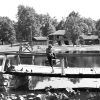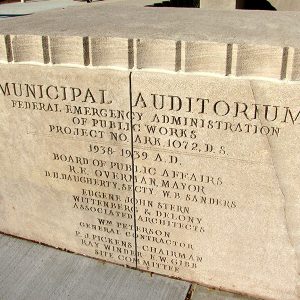calsfoundation@cals.org
Robinson Center Music Hall
aka: Joseph Taylor Robinson Memorial Auditorium
aka: Robinson Auditorium
Built in downtown Little Rock (Pulaski County) during the Great Depression as a Public Works Administration (PWA) project, the Joseph Taylor Robinson Memorial Auditorium—known since 1973 as the Robinson Center Music Hall—frequently hosts touring performances, including Broadway musicals, and is home to the Arkansas Symphony Orchestra. Named for Lonoke County native Joseph Taylor Robinson, who was governor of Arkansas and a U.S. senator, the Art Deco building on Markham Avenue near Broadway Street is a major Little Rock landmark.
Prior to the construction of the Robinson Center, Little Rock’s largest auditorium for concerts and other public events was at Little Rock High School (now called Central High School). Senator Robinson, a strong supporter of President Franklin Roosevelt’s New Deal, helped to bring several major projects to Arkansas, including a new civic auditorium. Unlike other New Deal programs, the PWA required local funding to accompany federal dollars. On January 26, 1937, Little Rock voters approved a bond referendum to help fund the auditorium, as well as additions to the public library and a city park for African Americans.
Construction of the auditorium began on December 27 of that year and was largely completed by December 8, 1939. The structure was received by the City of Little Rock on January 24, 1940, and formally dedicated on February 16, 1940. The building was named for Robinson, who had supported its creation; he had died in 1937. The total cost of construction was $855,000, more than $200,000 over the initial budget. In addition to the main stage and arena, including mezzanine and balcony seating, the building also holds lecture/exhibit halls and meeting rooms. As originally designed and built, the auditorium had two separate performance venues on an upper and lower level. Its team of architects included the firm of George Wittenberg and Lawson Delony, as well as associate architect Eugene Stern, all of whom had designed many other prominent buildings in Little Rock and around Arkansas.
Among the first events hosted in the auditorium were high school basketball games, but orchestral performances, ballet, and traveling theater rapidly came to the impressive new building. During the 1940s, the building also was used as a community center, offering ping pong, shuffleboard, bridge, checkers, and domino tournaments. Among the many famous performers and speakers to appear at the Robinson Memorial Auditorium in the 1940s were Louis Armstrong, Katharine Hepburn, Ella Fitzgerald, Mae West, Gene Autry, Bob Hope, Ethel Barrymore, Duke Ellington, Guy Lombardo, Eleanor Roosevelt, and Dwight D. Eisenhower. Some performers would offer two shows on the same day to different audiences, one upstairs and one downstairs. Elvis Presley performed at the auditorium in 1955 and 1956; for the first appearance, he was paid $150, but he grossed $9,000 when he returned a year later.
During the 1940s and 1950s, seating in the auditorium was often segregated by race. Many sought to overturn this policy in the wake of the desegregation of Little Rock’s school system. In 1961, after Duke Ellington canceled a concert due to the segregated seating. music promoter Jim Porter Jr. and others approached the auditorium commission about reversing this policy, though the commission refused. By the time Louis Armstrong performed there in September 1966, however, this policy had ended.
The Arkansas Symphony Orchestra made the Robinson Memorial Auditorium its home in 1973, the same year the building underwent extensive renovation, with underground parking added in the place of the lower performance hall. An attached hotel was erected to the east. That same year, the name was formally changed to the Robinson Center Music Hall. Famous acts continue to appear at the Robinson Center, including traveling Broadway shows such as Les Miserables, Riverdance, and Wicked. After the renovation, the auditorium could seat 2,609.
The building was added to the National Register of Historic Places on February 21, 2007. In 2012, the Little Rock Convention and Visitors Bureau announced plans for an extensive upgrade of the center’s facilities, including an expanded lobby and stage, as well as acoustical and technological improvements. Work began in 2014 and was completed in 2016. Major changes included the addition of a ballroom with an outdoor terrace overlooking the Arkansas River, restoration of the building’s exterior, and improvements to the performance hall area, especially the addition of box seating.
For additional information:
Harrison, Eric E. “Curtain Lifts on $70M Robinson Center Revamp.” Arkansas Democrat-Gazette, November 11, 2016, pp. 1A, 8A.
“Joseph Taylor Robinson Memorial Auditorium.” National Register of Historic Places nomination form. On file at Arkansas Historic Preservation Program, Little Rock, Arkansas. http://www.arkansaspreservation.com/National-Register-Listings/PDF/PU4546.nr.pdf (accessed February 8, 2022).
Roy, F. Hampton, Sr., and Charles Witsell Jr. How We Lived: Little Rock as an American City. Little Rock: August House, 1984.
Steven Teske
CALS Encyclopedia of Arkansas
 Arts, Culture, and Entertainment
Arts, Culture, and Entertainment Ballet Arkansas
Ballet Arkansas Early Twentieth Century, 1901 through 1940
Early Twentieth Century, 1901 through 1940 Recreation and Sports
Recreation and Sports Bailey Reelection Campaign
Bailey Reelection Campaign  Orchestra
Orchestra  Robinson Center Cornerstone
Robinson Center Cornerstone  Robinson Center Music Hall
Robinson Center Music Hall  Robinson Grand Opening
Robinson Grand Opening  J. V. Satterfield and Maureen O'Hara
J. V. Satterfield and Maureen O'Hara 




(2013) The Joe T. Robinson Auditorium was always very special to me, as I saw many wonderful acts there in addition to tap-dancing across the stage when I was a student of Dorothy Donaldsons. I saw Carmen, Eddie Arnold, and many more acts when I lived in Little Rock. It was always a wonderful place to see performances. I am so glad that it is being renovated. Thanks to all those involved.
Media reports at the time of the buildings opening did not distinguish between events taking place in the lower convention hall or the upper music hall and would often refer to them all as taking place in the auditorium (meaning the entire building). This lack of clarity has been carried over by subsequent writers including in the National Register of Historic Places nomination.
The early basketball games took place in the convention hall. These can be found in both Democrat and Gazette articles in January and February 1940. In fact, on February 16, two basketball games took place in the convention hall at the same time that the music hall was hosting its opening event. The newspapers on February 17 carried coverage of both sets of events.
Incidentally, the first event in the building was a dance on October 4, 1939, in the convention hall, preceding basketball by three months.